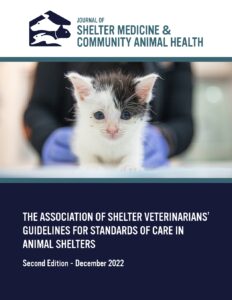In December 2022, the Association of Shelter Veterinarians (ASV) released the second edition of the Guidelines for Standards of Care in Animal Shelters, a comprehensive resource aimed at enhancing the welfare of animals in shelter environments.
An Overview of the Updated ASV Guidelines
The second edition of the Guidelines for Standards of Care in Animal Shelters provides a clear, practical roadmap for any organization caring for multiple animals. Developed by 19 shelter veterinarians with extensive, hands-on experience, the guidelines reflect the daily realities of shelter work—from ensuring animal well-being to supporting staff, volunteers, and the broader community. With a focus on behavioral health, capacity for care, and operational efficiency, the guidelines equip shelters with the tools to provide compassionate, sustainable care in a constantly evolving field.

Key Updates in the Second Edition
- Ethical Framework: The guidelines have transitioned from the Five Freedoms model to the Five Domains, offering a more nuanced approach to animal welfare that emphasizes both the mitigation of negative states and the promotion of positive experiences.
- Capacity for Care: There’s a renewed focus on shelters operating within their capacity to ensure they can meet the physical, medical, and behavioral needs of each animal.
- Behavioral Health: The guidelines underscore the importance of behavioral well-being, advocating for enrichment activities, stress reduction, and positive human-animal interactions.
- Medical Care: Updated recommendations emphasize preventive care, timely medical interventions, and pain management to maintain optimal health.
- Facility Design: Guidance is provided on housing design to reduce stress and disease transmission, including recommendations for proper ventilation, sanitation, and enrichment opportunities.
The updated guidelines serve as an essential tool for shelter personnel, including administrative, medical, behavioral, and animal care staff, as well as volunteers and foster caregivers. By implementing these standards, shelters can improve animal welfare, enhance public perception, and increase overall operational efficiency.
For a detailed understanding and to access the full guidelines, visit the Journal of Shelter Medicine and Community Animal Health through this link.
Reference:
The Association of Shelter Veterinarians. (2022). The Guidelines for Standards of Care in Animal Shelters: Second Edition. Journal of Shelter Medicine and Community Animal Health, 1(S1), 1–76. https://doi.org/10.56771/ASVguidelines.2022
